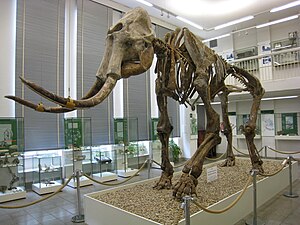Steppe mammoth
| Steppe mammoth | ||||||||||||
|---|---|---|---|---|---|---|---|---|---|---|---|---|

Skeleton reconstruction in the Spengler Museum |
||||||||||||
| Temporal occurrence | ||||||||||||
| Middle Pleistocene | ||||||||||||
| 750,000 to about 200,000 years | ||||||||||||
| Locations | ||||||||||||
|
||||||||||||
| Systematics | ||||||||||||
|
||||||||||||
| Scientific name | ||||||||||||
| Mammuthus trogontherii | ||||||||||||
| ( Pohlig , 1885) | ||||||||||||
The steppe mammoth ( Mammuthus trogontherii ) was a mammoth from the Middle Pleistocene of Eurasia . This elephant probably evolved from the southern elephant ( Mammuthus meridionalis ) in the Lower Pleistocene in Siberia , which it replaced from the Middle Pleistocene 750,000 - 500,000 years ago. With a shoulder height of up to 4.7 m, it is one of the largest known proboscis . It is believed that these animals could weigh up to ten tons . The spiral-shaped tusks of the males could be over 5 m long, but were more easily curved than in the later woolly mammoth ( Mammuthus primigenius ).
Steppe mammoths were better adapted to grass food than southern elephants and penetrated far into steppe areas . But they also lived in forest landscapes, which is shown by finds from eastern England in a layer of peat containing forest plants. Mammuthus trogontherii is one of the first mammoth species that was adapted to life in cold regions due to its thick hair. The woolly mammoth, which developed from the steppe mammoth in North Asia, appeared in Europe about 250,000 years ago and completely replaced its predecessor after a short transition period.
One of the most complete skeletons of a steppe mammoth was found and exhibited in Kikinda , Serbia, in 1996 . The find is a female with a total height of 3.7 m and 3.5 m long tusks. The body weight of the living mammoth is estimated at seven tons. Males in this area could have been even larger and armed with more powerful tusks.
In 2009, for example, in the coal mine of the Serbian town of Kostolac, in the immediate vicinity of the excavation site of the former Roman border town of Viminatium, the almost intact skeleton of a male steppe mammoth ( Mammuthus trogontherii ) was discovered, which was reconstructed almost 4 m high and an estimated 9.4 to 9.7 t weighed. It has been exhibited there in an underground museum since 2014. The only assembled skeleton in Germany is in the exhibition in the Spengler Museum in Sangerhausen .
literature
- Jordi Augusti, Mauricio Antón: Mammoths, Sabertooths, and Hominids. 65 Million Years of Mammalian Evolution in Europe. Columbia University Press, New York NY et al. a. 2002, ISBN 0-231-11640-3 .
- Adrian Lister, Paul Bahn: Mammoths - Giants of the Ice Age. Thorbecke Verlag, Sigmaringen 1997, ISBN 3-7995-9050-1 .
- Zoran Markovic, Desa Djordjevic, M. Milivojevic: Description of the habitat of Mammuthus trogontherii from late Middle Pleistocene, on the basis of the accompanying flora and fauna (northern rim of the Balkan Peninsula - Loc. Kikinda). In: Вера Михайловна Подобина (ed.): Эволюция жизни на Земле. = Evolution of life on the earth. Материалы I-го междунар. симп., 24–28 нояб. 1997 г., Томск. Naučno-techničeskoj literatury, Tomsk 2001, ISBN 5-89503-120-X , pp. 123–124.
Web links
- Pictures of the mammoth in the Kikinda Museum
- Description of the Edersleben mammoth at www.harz-saale.de
Individual evidence
- ↑ Miloš Milivojević: Excavation, reconstruction and conservation of Steppe Elephant from the clay pit of the building material factory “Toza Marković” at Kikinda (/ Serbia). Bulletin of the Natural History Museum 4, 2011, pp. 51–64 ( [1] )
- ^ Adrian M. Lister, Vesna Dimitrijević, Zoran Marković, Slobodan Knežzević and Dick Mol: A skeleton of 'steppe' mammoth (Mammuthus trogontherii (Pohlig)) from Drmno, near Kostolac, Serbia. Quaternary International 276-277, 2012, pp. 129-144, doi : 10.1016 / j.quaint.2012.03.021 .
